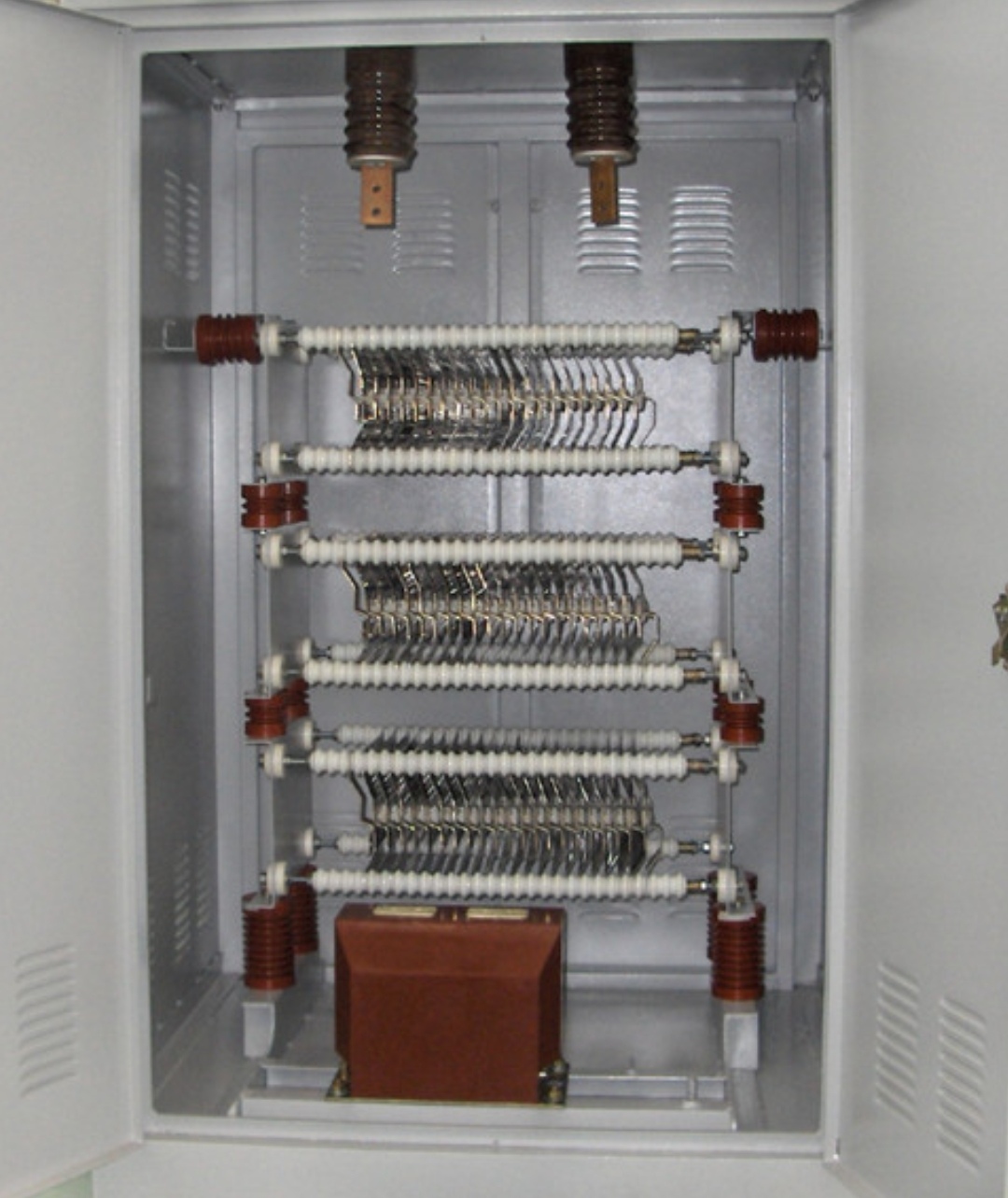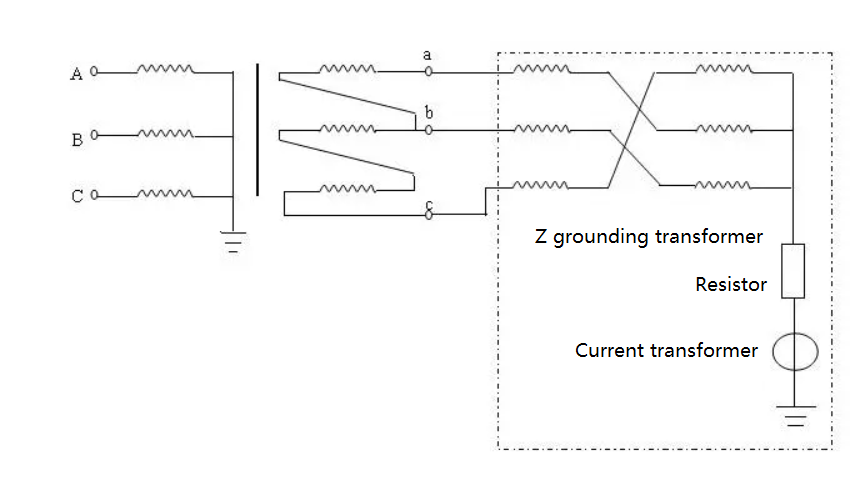What is a Neutral Grounding Resistor (NGR)? How Does it Work?

What is a Neutral Grounding Resistor (NGR)?
A neutral grounding resistor (NGR) is a crucial component in electrical systems designed to limit fault current during a ground fault in a three-phase power system. It is a type of resistor that is inserted between the neutral point of a system – such as a transformer, generator, or motor – and the ground. The main function of a NGR is to prevent electrical or electronic equipment from being struck by lightning.Generally, by connecting the neutral point of a transformer or generator to the ground through a resistor, NGRs help control the current that flows through the system during a fault. In this way, we can make sure the safety of the system and minimizes potential damage. Nowadays, NGRs are vital for maintaining system integrity and preventing catastrophic failures that could result from unchecked fault currents.

Neutral Grounding Resistor Working Principle
The working principle of neutral grounding resistor is that the current flows into the earth (ground) from the grounding device and then flows through the earth to another grounding or spreads to a distant resistance. And the current generated by lightning is introduced to the earth through the lightning rod. We can say, the working principle of NGR is followed by Ohm’s law - I=V/R, where I is the current, V is the voltage, and R is the resistance.Grounding is also an effective means to protect personal safety. When the phase line caused by some reason (such as poor wire insulation, line aging, etc.) and the device shell touch, the device shell will have a dangerous voltage, and the resulting current will pass through the ground wire to the earth, thus playing a role in personal safety protection.

The size of the NGR directly reflects the good degree of contact between the electrical device and the "ground", and also reflects the scale of the grounding network.
The concept of neutral grounding resistor is only applicable to small grounding networks. With the increase of ground grid area and the decrease of soil resistivity, the inductive component of ground impedance plays a more and more important role, and the ground impedance design should be adopted for large ground grids.
What are the Advantages of NGR?
Using a Neutral Grounding Resistor (NGR) for generator protection offers numerous benefits. Firstly, it enhances the safety of both personnel and equipment by limiting fault current and voltage, thereby reducing the risk of electrical shocks and equipment damage. This protective measure also improves the reliability and availability of the generator by minimizing the potential for damage during ground faults, leading to fewer interruptions and less downtime.Additionally, NGRs facilitate better fault detection and isolation by providing a measurable and controllable current that protective relays can easily sense. This capability ensures quicker identification and isolation of faults, preventing extensive damage and enabling faster repairs. Moreover, NGRs help reduce interference and harmonics in the system by minimizing zero-sequence currents and voltages, which improves overall power quality and communication signals. Incorporating an NGR into your generator protection strategy not only ensures enhanced safety and reliability but also contributes to improved system efficiency and performance.
What is the Resistor Between Neutral and Ground?
The resistor between neutral and ground is the core component of the NGR. This resistor is specifically designed to limit the fault current to a safe level. Its resistance value is carefully calculated based on the system's requirements, ensuring it can handle the fault current without overheating or failing. The resistor's role is critical in maintaining the safety and stability of the electrical system during a ground fault. By dissipating the fault current's energy, the resistor prevents potential damage to the system's components, thus ensuring long-term reliability.Where is NGR Used?
NGRs are commonly used in various applications where the safety and stability of the electrical system are paramount:Power Plants
NGRs are installed in power plants to protect generators and transformers from ground faults. They help in maintaining the integrity of the power generation process.
Industrial Facilities
Many industrial operations use NGRs to safeguard their electrical equipment and ensure continuous operation. Industries with heavy machinery and sensitive equipment benefit greatly from NGRs.

Mining Operations
In mining, NGRs protect critical equipment from ground faults, enhancing safety and reliability. The harsh conditions in mining operations make NGRs indispensable.
Commercial Buildings
Large commercial buildings often utilize NGRs to maintain the safety of their electrical systems. In buildings with complex electrical networks, NGRs provide the necessary fault current control.
Marine Applications
Ships and offshore platforms use NGRs to protect electrical equipment from ground faults, ensuring the safety and reliability of their operations.
Renewable Energy Systems
Wind farms and solar power plants implement NGRs to safeguard their electrical infrastructure, improving overall system resilience.
Data Centers
In data centers, NGRs are essential for protecting servers and other critical IT infrastructure from electrical faults, ensuring continuous data availability and system integrity.
Above are all the fields that neutral grounding resistors widely used, so actually, it exists in everywhere we can see.
What is the Difference Between NGR and NGT?
While NGRs and neutral grounding transformers (NGTs) both serve the purpose of controlling fault currents, they differ in their design and application. NGRs use resistors to limit the fault current, while NGTs use transformers. NGTs are typically used in high-voltage systems where a direct resistor might not be practical. They provide a means to step down the voltage before applying the resistance, making them suitable for different scenarios compared to NGRs. The choice between NGR and NGT depends on the specific requirements of the electrical system, including voltage levels, fault current characteristics, and installation constraints.
Why NGR is not used for more than 11KV system?
Though neutral grounding resistors are very popular in many electrical systems. However, their application is generally limited to systems with voltages up to 11KV. There are several reasons for this limitation, rooted in the principles of electrical engineering and practical considerations.Insulation Requirements
One of the primary reasons NGRs are not used in systems above 11KV is the insulation requirements. At higher voltages, the insulation needed to safely contain the electrical energy becomes significantly more complex and costly. The physical size and design constraints of the resistor and associated equipment would increase, making it impractical for higher voltage applications. The higher the voltage, the greater the need for robust insulation to prevent arcing and other potential faults.
Heat Dissipation
As voltage levels increase, the fault currents can become substantially larger. Managing the heat generated by these higher currents poses a significant challenge. NGRs at higher voltages would need to dissipate more heat, requiring more advanced cooling solutions. This makes the design and maintenance of such systems more complicated and expensive. In high-voltage systems, the heat generated during fault conditions can exceed the thermal limits of the resistor materials.
Cost and Complexity
The cost of designing and maintaining an NGR system for voltages above 11KV is another limiting factor. The increased insulation, larger physical size, and enhanced cooling systems required for higher voltages lead to significantly higher costs. Additionally, the complexity of the system increases, requiring more sophisticated monitoring and maintenance protocols to ensure safe and reliable operation. This complexity often makes alternative grounding methods more appealing for higher voltage applications.
Alternative Grounding Methods
For systems above 11KV, other grounding methods are typically used to control fault currents. These include neutral grounding transformers (NGTs) and high-resistance grounding (HRG) systems. NGTs can handle higher voltages by stepping down the voltage to a level where resistors can be applied effectively. HRG systems limit the fault current to very low levels, providing protection without the need for large resistors. These alternatives offer more practical solutions for high-voltage systems, addressing the limitations of NGRs.
Safety Considerations
Safety is a paramount concern in high-voltage systems. The risks associated with ground faults increase with voltage, and the potential for catastrophic failures becomes more significant. NGRs in high-voltage systems would need to be designed with extremely high safety margins, further increasing the complexity and cost. Ensuring reliable operation and protection in such systems often leads engineers to prefer other grounding methods that are better suited to high-voltage applications.
How to select a right neutral ground resistor?
Choosing the right neutral ground resistor for your system is critical to ensuring optimal protection and performance. Here are the key factors to consider when making your choice:1. System voltage
The voltage level of the system is the primary consideration. Make sure the rated voltage of the NGR is appropriate for the specific voltage of your generator, transformer or motor.
2. Expected fault current
Determine the maximum fault current that the system can safely handle. The NGR should limit the fault current to a level that the device can withstand without damage. This is calculated using Ohm's Law (I = V/R) and you need to balance the resistance to reach the desired current level.
3. Fault condition duration
Consider the duration of time the NGR needs to process the fault current. This includes the time required for the protection device to detect and isolate the fault, and the resistor must be able to withstand the thermal stress of the fault current without degradation during this time.
4. Heat capacity
The NGR must have sufficient heat capacity to dissipate the heat generated in case of failure. Make sure the NGR can handle the heat load without overheating, which could lead to failure or fire.
5. Environmental conditions
Consider the environmental conditions of the NGR installation. Factors such as ambient temperature, humidity, and corrosive elements can affect the performance and lifetime of NGR.
6. Compliance with standards
Ensure that NGR complies with relevant industry standards and regulations. Compliance with standards such as IEEE, IEC or local electrical codes ensures that NGR is designed and tested to operate safely and reliably.
7. Physical size and installation limitations
Consider the physical size of the NGR and the available installation space. Ensure that the selected NGR meets space constraints for easy maintenance and inspection.
Neutral grounding resistors are essential components in modern electrical systems, offering significant benefits in terms of safety, stability, and operational continuity. By understanding their working principles and applications, you can make informed decisions about incorporating NGRs into your systems. Jinftry, with its expertise in electrical components, can provide the right solutions for your needs, ensuring your systems operate safely and efficiently.
Statement
All articles (images, texts, audio) on this site are uploaded and shared by users, or integrated from relevant internet sources, only for user's learning. If your rights are violated, please contact the administrator to delete! Link to this article: https://www.jinftry.com







